Annex II BIS - Asian Highway Design Standards for Road Safety
This document shall be read in conjunction with other documents forming the Intergovernmental Agreement on the Asian Highway Network.
The contents of this document are structured in the following wording:
- “Shall” and “shall not” give mandatory requirements
- “Should” and “should not” give recommendations which are expected to be adopted unless there is a strong reason otherwise
- “May” and “need not” indicate potentially desirable options depending on circumstances
Asian Highway network member countries shall make every effort to comply with the design standards and are encouraged to give thorough consideration in adopting the recommendations given in the related design guidelines.
Member countries are encouraged to ensure that new roads of the Asian Highway network are 3-star or better (based on star ratings of the International Road Assessment Programme) for all road users and that more than 75 per cent of travel on existing roads is 3-star or better for all road users.
Member countries shall undertake road safety audit for road improvement projects in the Asian Highway network. Member countries shall also conduct road safety inspection (also known as road safety audit in some countries) for designated Asian Highway routes, within a reasonable time frame and at regular intervals, in accordance with practices in the respective countries.
Road safety infrastructure facilities shall be provided in the network with the view of optimized provision and consistency. The need for adequate flexibility is acknowledged given the existing road conditions and diverse circumstances among member countries.
Adequate attention should be given to the integration of road safety infrastructure facilities with streetscape design and the landscape as well as mitigation of any adverse impacts on the environment. Countries shall take advantage of the following road improvement projects and activities to elevate road safety in the Asian Highway network:
- Online road improvement or upgrading projects
- New bypass projects
- New addition of roads to the Asian Highway network
- Dedicated road safety improvement projects
- Routine maintenance activities
Where design speed or speed limit are quoted as criteria, due consideration should be given to the actual operating speeds of traffic.
The terms “nearside” and “offside” refer to the right side and left side respectively in the direction of travel where driving is on the right side of aroad. They refer to the left side and right side respectively in the direction of travel where driving is on the left side of a road. Nearside and offside are equivalent to passenger side and driver side respectively.
It is at the liberty of member countries and other bodies to make use of this document for roads other than Asian Highway routes.
Development of Road Infrastructure Safety Facility Standards for the Asian Highway Network
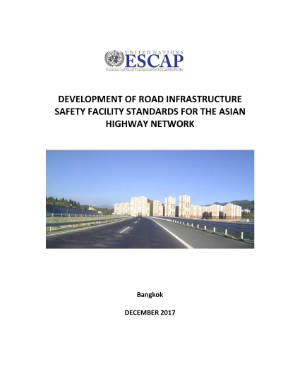
Road safety is a sustainable development issue that needs greater attention as road traffic fatalities and injuries place a significant burden on national economies. The Asia-Pacific region accounted for 58% of the global road traffic deaths in 2013. Between 2010 and 2013, while 16 Asian Highway member countries were successful in reducing road fatalities, others failed to do so. The seventh Goal of the “updated Regional Road Safety Goals and Targets for Asia and the Pacific, 2016-2020” emphasizes on developing the Asian Highway network as a model of road safety.
Studies show a strong correlation between infrastructure design and road safety and road engineering and design can influence the severity of the crashes. In this regard, the Annex II to the Intergovernmental Agreement on the Asian Highway Network which entered in to force on 4 July 2005 includes design standards for the Asian Highway Network. However, the design standard does not provide adequate guidance on road infrastructure safety facilities.
As one of the initiatives to address the road safety problem on the Asian Highway Network, the ESCAP secretariat, in association with the Korea Expressway Corporation conducted a study on the development of technical standards on road infrastructure safety facilities for the Asian Highway Network. A detailed literature review on existing standards for infrastructure element design and specification to address road safety in the Asian Highway member countries and other international sources was conducted. A list of 36 road infrastructure safety facilities was prepared. Detailed information on road infrastructure safety practices was collected from five participating countries. A survey was conducted to assess the prevalence, types and design standards of road safety facilities in the Asian Highway member countries in end 2015. The international road assessment programme (iRAP) methodology was used to illustrate how relative risk levels would change if road infrastructure safety facilities were added to the existing Asian Highway standard. It could be concluded that there is potential to promote the use of a broader range of road infrastructure safety facilities for the Asian Highway Network.
The study suggested that the Intergovernmental Agreement on the Asian Highway Network provides an adequate institutional platform for providing guidance to member countries in a number of areas and could further be used for promoting a coordinated approach to the development and adoption of standards of road infrastructure safety facilities. The study emphasizes on providing guidance to the Asian Highway member countries through a dedicated new annex to the Intergovernmental Agreement on the Asian Highway Network. In this regard, proposed mandatory minimum design standards of road infrastructure safety facilities for the Asian Highway Network which could serve as a draft Annex II bis “Asian Highway Design Standards for Road safety” to the Intergovernmental Agreement on the Asian Highway Network; and related design guidelines of road infrastructure safety facilities which could serve as a recommended practice for the Asian Highway Network have been developed. The study recommended the Asian Highway member countries to consider adopting and implementing technical design standards of road infrastructure safety facilities towards improving road safety on the Asian Highway Network.
Save lives: a road safety technical package
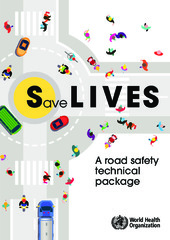
Each year, 1.25 million people die as a result of road traffic crashes and as many as 50 million people are injured. They are the leading cause of death among people aged 15-29 years. Nearly half (49%) of the people who die on the world’s roads are pedestrians, cyclists and motorcyclists. In addition to the grief and suffering they cause, road traffic crashes constitute an important public health and development problem with significant health and socioeconomic costs. Much is known about preventing road traffic deaths and injuries. Based on this knowledge, a road safety technical package has been developed to support decision-makers and practitioners in their efforts towards reducing road traffic deaths and injuries and achieving the Sustainable Development Goal targets 3.6 and 11.2.
Save LIVES: a road safety technical package is an evidence-based inventory of priority interventions with a focus on Speed management, Leadership, Infrastructure design and improvement, Vehicle safety standards, Enforcement of traffic laws and post-crash Survival. The 6 strategies and 22 interventions recommended in the package are interrelated and should be implemented in an integrated manner to effectively address road traffic deaths and injuries. Since countries are at varying stages of addressing this problem, this road safety policy package should not be seen as a one-size-fits-all solution, but rather as a guide to support decisions for scaling up road safety efforts.
Safe Micromobility

This report examines the safety aspects associated with the increasing use of e-scooters and other forms of micromobility in cities. The rise of micromobility challenges existing regulations for urban traffic and forces policy makers to rethink them. The report considers a range of actions to make urban traffic with micromobility safe, including in street layout, vehicle design and vehicle operation, user education and enforcement of rules. It also asks whether a shift towards micromobility can have potential safety benefits.
Road Safety Annual Report 2019
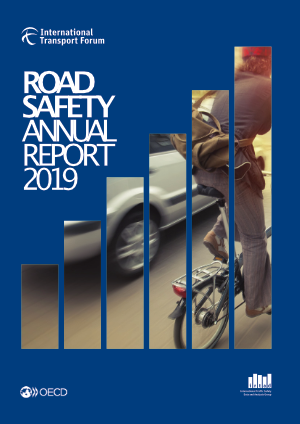
The IRTAD Road Safety Annual Report 2019 provides an overview of road safety performance for 41 countries. The report outlines the most recent road safety developments there and provides comparative data for the main road safety indicators. It also offers detailed analysis by road user, age group and types of road. It describes the crash data collection process in IRTAD countries, the road safety strategies and targets in place and information on recent trends in speeding, drink-driving and other aspects of road user behaviour.
This manual explains good practices for roadwork sites, offering clear and simple guidance for CAREC road authorities to use to improve road safety at these sites for road users and workers alike. It offers information about the six-zone process, how to plan and implement a traffic management plan, and how to manage a safe worksite. This manual is essential reading for project managers, designers, supervision consultants, contractors, works supervisors and others who have a responsibility for safe worksites.
About the CAREC Road Safety Engineering Manuals
The series of road safety engineering manuals of the CAREC Program came from the endorsement of the CAREC Road Safety Strategy 2017-2030 by member countries. The strategy supports and encourages CAREC authorities to plan, design, construct, and maintain safe roads.
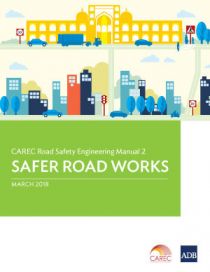
Country Statement: Islamic Republic of Afghanistan
CAREC Road Safety Engineering Manual 3: Roadside Hazard Management

Single vehicle “run-off road” crashes are a significant problem on CAREC roads. They are particularly severe and can occur anywhere and at any time. Identifying, investigating, and treating roadside hazards are significant road safety challenges along CAREC highways. It uses a roadside hazard management strategy and the clear zone concept to explain how CAREC road authorities can (i) identify roadside hazards, (ii) investigate how best to treat those roadside hazards, and (iii) implement effective safety improvements. The manual explains the three groups of safety barriers and offers options for safer roadside furniture.
About the CAREC Road Safety Engineering Manuals
The series of road safety engineering manuals of the CAREC Program came from the endorsement of the 2017-2030 CAREC Road Safety Strategy 2017-2030 by member countries. The strategy supports and encourages CAREC authorities to plan, design, construct, and maintain safe roads.
Safely Connected: A Regional Road Safety Strategy for CAREC Countries, 2017-2030
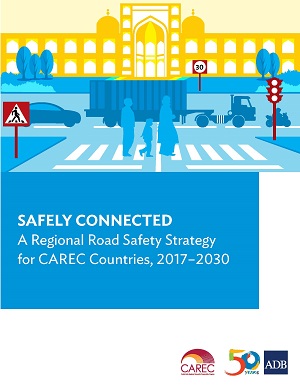
Road accidents are the sixth leading cause of death in Central Asia., with a road traffic death rate of 10 to 25 per 100,000. A framework is needed for Central Asia Regional Economic Cooperation (CAREC) member countries to effectively implement CAREC’s commitment to road safety. CAREC’s strategy envisions making its road corridors safe, efficient, and attractive to motorists. The target is to halve the number of CAREC road corridor fatalities by 2030—translating to 23,000 lives saved and 250,000 serious injuries prevented annually.
The strategy builds upon existing strengths within the region, addresses gaps, utilizes good practice, and mitigates risks. This publication embodies the CAREC countries’ commitment to make road safety a priority.
Pagination
- Previous page
- Page 2